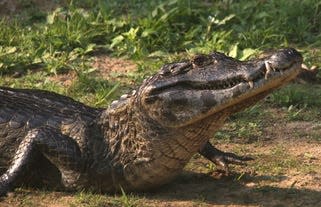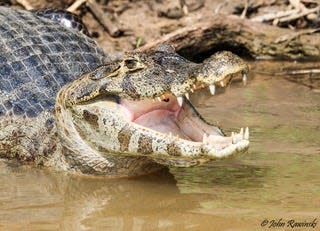Caimans are at the new Daytona aquarium: How do they differ from alligators and crocodiles?
One of the main attractions at the new Daytona Aquarium & Rainforest Adventure is the Reptile Den, where guests can see an American alligator swimming in its enclosure.
But just a few feet away, there is another animal enclosure housing a creature very similar to an alligator: A caiman.
Caimans, despite their similarities and the fact they are related alligators and crocodiles, are their own species.

Are caimans in the U.S.?
The reptile, which is not native to the United States, is part of the same family as the well-known American alligator and American crocodile and is easily mistaken for both.
If you are planning a visit to the aquarium or are wondering what makes caimans different, here's what you need to know.
Gators vs. Crocs: Crocodiles and alligators look alike, but here are the differences between the two reptiles
What are caimans?
Caimans are reptiles, members of the Alligatoridae family, who greatly resemble other species who belong to the same family, such as alligators and crocodiles.
They are found only in Central and South America, “widely distributed throughout the Amazon River basin,” according to Amazon Aid — a Virginia-based nonprofit organization.
“Consistent with the caiman’s proclivity for wet environments, its range overlaps much of the Amazon basin across Brazil and bordering countries.”
The largest caiman species, the Black caiman, can reach up to 15 feet from tail to snout. The smallest species is the Cuvier’s dwarf caiman — females can reach up to 4 feet and males up to 5 feet.
14-foot beast in Pinellas: How big are the alligators in Volusia-Flagler?
They typically live “along riverbanks and streams, but they especially thrive in floodplain lakes, wetlands and other inundated habitats with dense vegetation cover,” according to Amazon Aid.
Is a caiman a crocodile or an alligator?
Neither.
The three species are part of the same order, Crocodylia, which makes all three crocodilians.
Despite their overall similar appearance, caimans have their own differences.
“Alligators have a broad, rounded snout, while crocodiles have a longer, more pointed snout. Caimans have a snout that is somewhere in between the two,” according to American Oceans.
One of the easiest ways to distinguish alligators from crocodiles is by looking at their snouts.

“Alligators have a broad, rounded snout that is U-shaped when viewed from the front,” while crocodiles “have a more V-shaped snout that is longer and narrower than an alligator’s.”
A caiman’s snout is somewhere in between, “with a more pointed snout than an alligator but not as narrow as a crocodile’s,” according to American Oceans.
The caiman’s skin is also somewhat of a cross between the two: Crocodiles have rough skin with more pronounced bony plates, while alligators have smoother, less bony skin, according to American Oceans.
Aquarium exhibits: Heading to Daytona Aquarium & Rainforest Adventure? Don't miss these exhibits.
“The coloration of (a caiman’s) skin can vary depending on the species, habitat and age of the animal.”
Are there caimans in Florida?
Caimans are not a native species in Florida, but some are known to inhabit parts of the Everglades in Miami-Dade and Broward counties.
"Following protective legislation to prohibit trade in American alligators in the early 1950s, the number of imported caimans into the United States as pets markedly increased,” according to the University of Florida’s “The Croc Docs.”
Caimans there “occupy the same habitat as our native alligators and crocodiles, competing for food and other resources,” preying “upon birds, small mammals, fish and other reptiles, posing a threat to native wildlife.”
“Caiman are native to Central and South America, and their distribution in Florida will probably remain confined to South Florida because they cannot tolerate cold temperatures,” according to the Florida Fish and Wildlife Conservation Commission.
This article originally appeared on The Daytona Beach News-Journal: Caimans are at new Daytona aquarium: Are they alligators?
